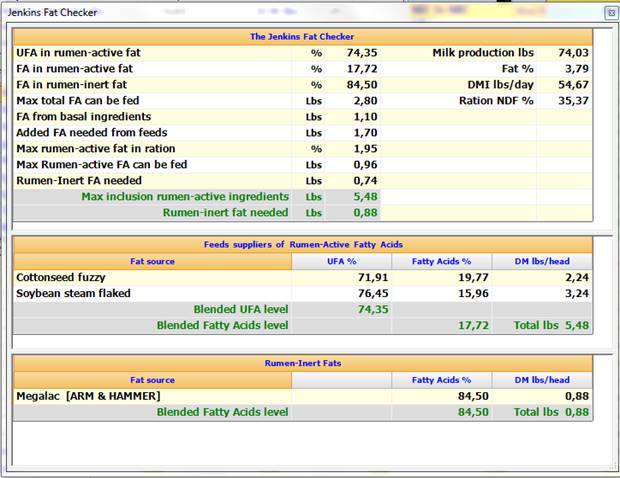
The NDS Jenkins Fat Checker is a theoretical fat feeding model that describes cow responses to added dietary fat developed by Dr. Tom Jenkins from Clemson University.
The rule of thumb of the model is that the amount of fat that can be safely included in the diets of lactating cows is roughly equal to the amount of fat it is secreted in milk. Also, it defines a maximum amount of rumen active fat (unsaturated fatty acids) that can be fed.
The feeds are classified on the basis of the kind of crude fat (Ether Extract) to provide an accounting of rumen active and rumen inert fat:
- Fat Type 1 classifies the fats in base feed ingredients like forages, grains and proteins;
- Fat Type 2 is fat in high fat feed ingredients like whole oil seeds, distillers grains and tallow. These are considered rumen active fats and usually should be limited on ration dry matter to avoid adverse affects on ruminal fermentation;
- Fat Type 3 is inert in the rumen due to high amounts of saturated fatty acids such as stearic and palmitic or because fat is in the form of calcium salts used to raise concentration of fat of ration dry matter.
The output model tell us:
1. If we are feeding too much rumen active fat or we can add more;
2. How much additional inert fat (e.g. calcium salts of fatty acids) can be added to the diet;
3. A suggested recalculation of the high fat ingredients to achieve optimal rumen active fat in the diet

Several parameters are taken into account:
UFA in rumen-active fat (%): blend of total Unsaturated Fatty Acid level (% FA) from rumen-active fat ingredients in the current diet. The UFA value for a fat source is the sum of the three main unsaturated fatty acids in the fat supplement and includes oleic (C18:1), linoleic (C18:2), and linolenic acids (C18:3). Note that fish oil fatty acids are not included in the calculation of UFA.
FA in rumen-active fat (%): blend of total Fatty Acid level from rumen-active fat ingredients in the current diet.
FA in rumen-inert fat (%): blend of total Fatty Acid level from rumen-inert fat ingredients in the current diet.
Max total FA can be fed (kg or lbs): it corresponds to the total fat secreted in milk. The biological rule of thumb is that the amount of fat that can be included safely in the diets of lactating cows is roughly equal to the amount of fat secreted with milk. It is based on metabolic data and the results of several researches are always very similar: total dietary fat can be equal to the total milk fat secreted.
FA from basal ingredients (kg or lbs): amount of fat supplied by the basal dietary ingredients (i.e., non-high fat ingredients).
Added FA needed from feeds (kg or lbs): subtracting from the maximum FA that can be fed the amount of fat supplied by the basal dietary ingredients you can get the total amount of fat that can be added by additional sources of fat.
Max rumen-active fat in ration (%): approximate maximum percentage on DMI of rumen active fat based on the NDF level of the basal diet. As NDF level of the diet increases, the amount of rumen active fat that can be fed increases as well. However, we generally try to keep NDF at appropriate level according the level of production of the lactating cows, not too high but safe, which automatically limits the amount of rumen active fat that can be added.
Max rumen-active FA can be fed (kg or lbs): the maximum amount of rumen active fat that can be placed into the diet based on maximum rumen-active fat proportion in the ration and current dry matter intake.
Rumen-Inert FA needed (kg or lbs): how much additional FA from rumen-inert fat (i.e. calcium salts of fatty acids) can be added to the diet.
Max inclusion rumen-active ingredients (kg or lbs): maximum amount of "rumen-active" fat ingredients that could be fed based on UFA content of these ingredients.
Rumen-inert fat ingredients needed (kg or lbs): allowable amount of "rumen-inert" fat ingredients that should be fed in order to get the defined maximum amount of total fatty acids in the diet.